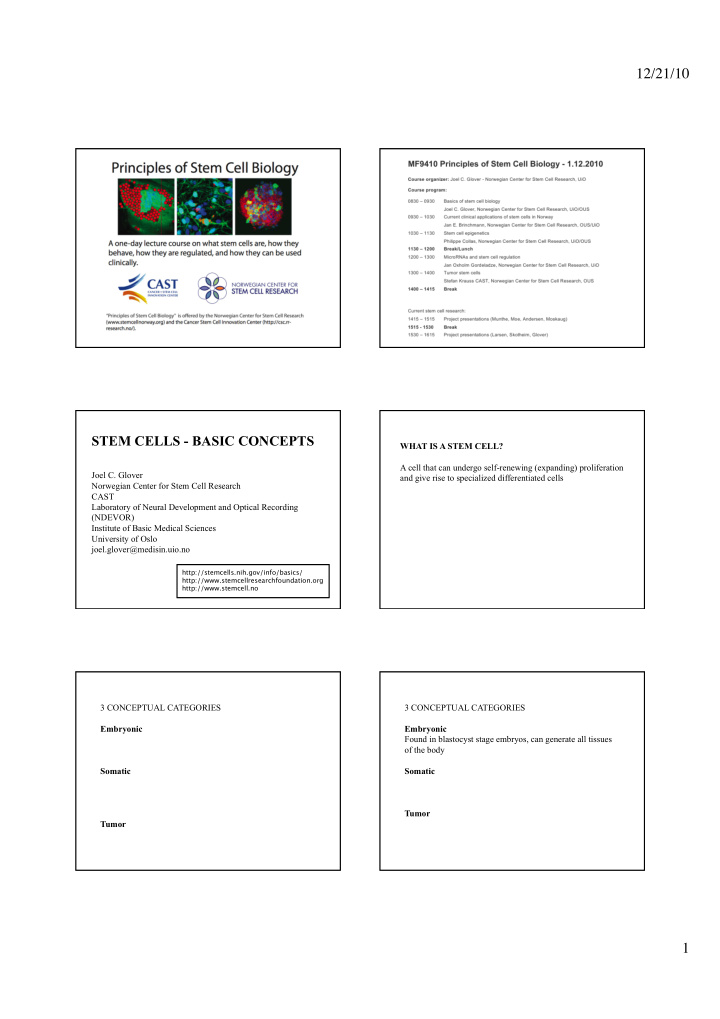



12/21/10 STEM CELLS - BASIC CONCEPTS WHAT IS A STEM CELL? A cell that can undergo self-renewing (expanding) proliferation Joel C. Glover and give rise to specialized differentiated cells Norwegian Center for Stem Cell Research CAST Laboratory of Neural Development and Optical Recording (NDEVOR) Institute of Basic Medical Sciences University of Oslo joel.glover@medisin.uio.no http://stemcells.nih.gov/info/basics/ http://www.stemcellresearchfoundation.org http://www.stemcell.no 3 CONCEPTUAL CATEGORIES 3 CONCEPTUAL CATEGORIES Embryonic Embryonic Found in blastocyst stage embryos, can generate all tissues of the body Somatic Somatic Tumor Tumor 1
12/21/10 3 CONCEPTUAL CATEGORIES 3 CONCEPTUAL CATEGORIES Embryonic Embryonic Found in blastocyst stage embryos, can generate all tissues Found in blastocyst stage embryos, can generate all tissues of the body of the body Somatic Somatic Found in fully-formed organs, can generate multiple cell Found in fully-formed organs, can generate multiple cell types characteristic of organ of origin. types characteristic of organ of origin. Tumor Tumor Found in tumors, can reconstitute new tumors of same type, presumed source of metastases THE CONCEPT OF STEM CELL POTENCY Totipotent fertilized egg (entire body) first few blastomeres Pluripotent embryonic stem cells (most - all cell types) embryonic germ cells embryonal carcinoma cells Multipotent somatic stem cells (several cell types) HISTORICAL PERSPECTIVE 3 CONCEPTUAL CATEGORIES Fertilized egg + first few blastomeres are totipotent Separated blastomere experiments of Driesch 1892 Embryonic Found in blastocyst stage embryos, can generate all tissues Embryonic stem cells first isolated from mouse blastocysts by Martin and of the body Evans & Kaufman 1981 “inner cell mass” Somatic established as expandable cell lines, are pluripotent Found in fully-formed organs, can generate multiple cell allowed for the generation of transgenic mice types characteristic of organ of origin. Embryonic stem cells first isolated from human blastocysts by Tumor Thomson et al, Gearhart et al 1998 Found in tumors, can reconstitute new tumors of same type, Established as expandable cell lines (first USA, now many countries presumed source of metastases including Sweden) Requires use of human blastocysts, obtained in connection with in vitro fertilization for couples with fertility problems 2
12/21/10 fra Larsen, 1. utg. fra Carlson, 3. utg. In vitro fertilization – typical procedure fra Carlson, 3. utg. fra Carlson, 3. utg. THE CONCEPT OF STEM CELL POTENCY Totipotent fertilized egg (entire body) first few blastomeres Pluripotent embryonic stem cells (most - all cell types) embryonic germ cells embryonal carcinoma cells Multipotent somatic stem cells (several cell types) 3
12/21/10 Embryonic stem cells: example of a potential use Bjørklund et al (2002) PNAS 99:2344-2349 Friling et al (2009) PNAS 106:7613-7618 Embryonic stem cells: example of a potential use Keirstead et al (2005) J Neurosci 25:4694-4705 4
12/21/10 3 CONCEPTUAL CATEGORIES Embryonic Found in blastocyst stage embryos, can generate all tissues of the body Somatic Found in fully-formed organs, can generate multiple cell types characteristic of organ of origin. Tumor Found in tumors, can reconstitute new tumors of same type, presumed source of metastases Keirstead et al (2005) J Neurosci 25:4694-4705 HISTORICAL PERSPECTIVE Previously known to exist in organs with obvious self-renewal (bone marrow, skin, intestinal epithelium), and in organs with some capacity to regenerate after cell loss (liver, muscle) Previously believed NOT to exist in organs with no obvious self-renewal (like brain) hHSCs in vitro from Torstein Egeland, More recently demonstrated in precisely such organs (like brain) IMMI, RH Johansson CB, Svensson M, Wallstedt L, Janson AM, Frisen J. Neural stem cells in the adult human brain. Exp CONCEPT OF THE STEM CELL “NICHE” Cell Res 1999; 253:733-736. embryo adult 5
12/21/10 Somatic stem cells: Remnants of embryogenesis? “Stages” of development: proliferation versus differentiation Stem cell Progenitor cell Precursor pluripotent unipotent (?) high proliferation low proliferation low differentiation high differentiation Signals for proliferation Signals for differentiation Role of the microenvironment Proliferative kinetics: relationship to expansion in vitro AN IMPORTANT QUESTION REGARDING (and to evolution!) SOMATIC STEM CELLS What is the differentiation potential of somatic stem cells? Organ-restricted (multipotent), or broader (pluripotent)? Much circumstantial evidence. Requirement for definitive studies proving full differentiation to specific cell types in vivo . number of cells = 2 n number of cells = n + 1 Somatic stem cells: examples of specific uses Hematopoietic stem cells have been used for years in the treatment of bone marrow and blood disorders such as leukemia, aplastic Anemia Skin transplants are de facto stem cell treatments More recent advances in regenerative medicine: Liver, connective tissue, etc…… (homotypic, as for bone marrow transplants) In the future: Tissues derived from heterotypic stem cell sources? (for example, nerve cells from hematopoietic stem cells or from fat stem cells) 6
12/21/10 Somatic stem cells: examples of specific uses Make pluripotent stem cells! Induced pluripotent stem cells (iPS cells): Pluripotent stem cells derived from somatic cells that have been reprogrammed to revert to a pluripotent state as in embryonic stem cells Takahashi & Yamanaka (2006) Cell 126:663-676 Takahashi & Yamanaka (2006) Cell 126:663-676 7
12/21/10 Embryonic Advantages: Clearly pluripotent, easy to expand and differentiate, platform for many model systems for studying normal and disease mechanisms The main message: Disadvantages: Not autologous, may cause tumors, derived from embryos STEM CELL BIOLOGY STILL PRESENTS MANY CHALLENGES Somatic Advantages: Autologous, already programmed towards specific cell types, lower risk What is needed is continued, integrated research into embryonic, of tumorigenesis somatic, and induced pluripotent stem cells Disadvantages: Restricted potential, some are hard to get, still carry genetic disease burden Induced pluripotent Advantages: Autologous, greater potential, platform for in vitro disease models Disadvantages: Harder to generate and expand, require genetic/epigenetic “harassment”, may enter senescence sooner 8
Recommend
More recommend